Chronology of Storm Events /
Hazel Affects Transportation /
The Effects of Hazel on Toronto Area Communities /
Southern Ontario Impacts /
Recovery /
Lives that were Taken
The Effects of Hazel on Toronto Area Communities
Humber River
Hazel's affects on the Humber River caused the most damage and destruction in the Toronto area. The waters rose rapidly, and with incredible force, smashed into communities that lined the river's floodplains. Houses were swept clean off their foundations and numerous lives were lost.
Today, on one of the hulking columns that supports the Bloor Street viaduct, at a height of about 25 feet, there still resides a blue horizontal line that has been painted on the concrete. The top of the line has been painted in the shape of waves, and figures resembling fish can be seen throughout the thickness of the line—it is the only adornment on the otherwise discolouring grey of the concrete. There is no plaque explaining what the line represents: the level that the waters of the Humber reached during Hazel.
Many incredible rescue efforts were made along the Humber on that fateful night in 1954, even though the current was so strong, jeopardizing most boats launched into the waters. Eventually they would need to be rescued themselves. Despite the difficulties, many lives were saved because of the quick action of police, fire personnel and citizens.
A police radio message described the futility of launching boats into the river: "Twenty-three cruiser here at the Humber. The life-saving people say not to launch a boat of any size… repeat, of any size… in this river. Nothing can make it. Anyone in it will be killed for sure." (Toronto Daily Star, October 15, 1964)
The difficulty in launching boats proved to be a source of frustration for bystanders attempting to rescue stricken people in the flood's path, as described by Det.-Sgt. Jack Gillespie, referring to officers "...within hearing distance of these awful screams from women and children leaning out windows and hanging onto rooftops, but we couldn't get close to them until we got the boats and even when they came, some of them were too small. If you didn't have a 15 horsepower-motor, it was no good." (Toronto Daily Star, October 16, 1954)
After the storm, 17 bodies remained missing in the Humber Valley. Operation 'Exercise Search' began with 800 militia troops (15 militia groups and eight army reserve units), equipped with boats, pike poles, flamethrowers, bulldozers, spades and crowbars.
Mount Dennis
- The community of Mount Dennis, next to the Humber River, experienced very high floodwaters, with street lights running down the middle of the flooded river at one location.
- Cynthia Avenue properties had 10 feet (three metres) of water around homes and approximately 20 feet (6.1 metres) of front lawns eroded by the river, leaving cliffs bordering properties.
- In south Mount Dennis, where the Black Creek traverses and the water is normally one foot (0.3 metres) deep, and so narrow that a person is able to jump across, the creek swelled to cover Humber Boulevard, Porter Avenue and Cordella Avenue.
Old Mill
- George Eliot, a 33-year-old telephone lineman, survived for four hours in the flooded Humber River near Old Mill by clinging to a tree before Max Hurley, who was able to navigate the river with his boat, rescued him.
- Firefighters from the Kingsway-Lambton Fire Station attempted to rescue people stranded in a car by floodwaters on the Humber. The fire truck the men were driving became stuck on a flooded street and overturned, tossing the men into the water. Five of the nine men on board died.
Raymore Drive
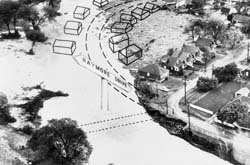 The Humber River rose and flooded the lower portion of Raymore Drive, removing 1,200 feet (366 metres) of the street and 14 homes, killing more than 30 people. Raymore Drive curved in the southern portion, with Gilhaven Avenue acting as a radius. The lower section was devastated, removing homes on both sides of the street. On the east side of the street, a few trees remained, but on the west side, the street was lined with rocks, boulders and debris that was transported by the floodwaters.
The Humber River rose and flooded the lower portion of Raymore Drive, removing 1,200 feet (366 metres) of the street and 14 homes, killing more than 30 people. Raymore Drive curved in the southern portion, with Gilhaven Avenue acting as a radius. The lower section was devastated, removing homes on both sides of the street. On the east side of the street, a few trees remained, but on the west side, the street was lined with rocks, boulders and debris that was transported by the floodwaters.
- A Bailey bridge, installed to span the river south of the Weston fairgrounds, became a battering ram against homes on Raymore Drive, tearing them from their foundations.
- John Neil returned from a bachelor party to find the street flooded. Thinking that his family and neighbours had been evacuated, he proceeded to help evacuate residents of Gilhaven Avenue, and did not realize until the next morning that his family was among the casualties.
- The high loss of life has been blamed on complacency, a feeling that the Humber could not threaten residents. Older residents were quoted as saying that "It's never gone this high before." In one situation, as a house was flooded to the ground floor, the occupants moved the furniture to the neighbour's house, which caused the demise of both households' occupants due to the extra time taken to move the furniture.
- People were warned to leave the area. One man, George Bridger (17) recalled wading through water, sometimes up to his nose, to warn people to leave. Mrs. Thomas Waheling stated, "If he hadn't awakened me, I'd never have got out."
- Herb Andeus of Gilhaven Avenue said he woke up and found water at his back fence. He commented that if everyone had heeded the warning, the death toll would not have been so high.
- David Philips, a resident of Raymore Drive, described the efforts to save people on the river: "As I stood there, I could hear people screaming, I could see the houses tumbling into the river. I ran down to the river to try and help, but there was nothing we could do. We tried to get a boat out, but the water was too rough. The firemen tried going out with ropes, hand-over-hand, but it was just too difficult, the river was too swollen. And the water just kept coming. We were forced to stand there and watch people die." (Toronto Star, October 14, 1984)
- When the flood was over and the damage assessed, it was decided that the area of Raymore Drive flooded so catastrophically that it would not be zoned for residential development any longer.
Scarlett Road
- On Scarlett Road, a dog barking in the backyard roused his owners, who discovered the rising waters. The warning saved 17 people, but 24 dogs were lost. The dog was confined in his backyard kennel and the water was almost over his back. "I found him (the dog) almost drowned in the few minutes it took the waters to rise over his back. I unchained him and stumbled back in the water to the house. Then I got up the rest of my family and those next door," said Herbert Sparrow. (Toronto Daily Star, October 25, 1954)
- On Scarlett Road, a woman and her family was trapped in a house that was surrounded by floodwaters 10 feet (3 metres) deep; firefighters 100 feet (30.5 metres) away could not reach the family to help.
Thistletown
- Two men, Murray and Clyde Deadder, were killed in this community when their car was caught in floodwaters, and 12 families were left homeless.
- Two bridges were undermined when their approaches were washed away, and the 600-person village was isolated by the floodwaters.
- At the Hospital for Sick Children, the pump house was disabled, but this could not be reported to the main Toronto hospital because of the isolation.
Weston
- Weston is a community nestled along the east side of the Humber River, but the community had been located on the western flatland. Following several disastrous floods in the 1800s, town officials decided to move the community to prevent further loss of life and property—a move that undoubtedly saved lives during Hazel. The former Weston town location is now the site of the Weston Golf and Country Club.
- Jim Crawford was a 23 year old off-duty police officer the night Hurricane Hazel hit Toronto. He picked up his brother, Pat, and left to help. Crawford met Herb Jones, a contractor on Fairglen Crescent. Using Jones' 25-horsepower boat they headed out into the river and ended up saving 50 lives. They remained at it until daybreak. "By that time, I was soaked right through and had the shivers. I just couldn't stop shaking. I think probably a lot of that was not being cold and wet, but being scared, too." (Toronto Star, May 27, 1984)
- Mr. and Mrs. Joseph Ward fled to the roof when their house was struck by another house that was set afloat by the flood. After several attempts by a helicopter, they were finally saved.
- Donald Curtis was rescued from the roof of a neighbour's house, but his mother was lost. Donald attempted to lift his mother onto the roof after he climbed up there himself, but could not. Then the house collapsed forcing him to jump to the neighbour's roof, where he stayed until rescued.
Woodbridge
- Woodbridge was the first community on the Humber to be hit with the floodwaters from Hazel.
- The river in this community is normally 65 feet wide, but during the flood it extended to 350 feet (107 metres) at its narrowest point.
- Nine people died and several hundred more were homeless.
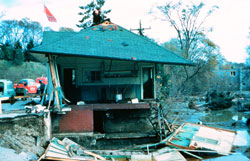 Twenty houses and every trailer in Glendale Mobile Home Park were destroyed, and another 50 houses in Pine Grove and Woodbridge were damaged.
Twenty houses and every trailer in Glendale Mobile Home Park were destroyed, and another 50 houses in Pine Grove and Woodbridge were damaged.
- Casualties included Mr. and Mrs. Donald Reid and their daughter, Dallas, who had left their house in Woodbridge, as they feared they would be in jeopardy because of the floodwaters. En route to Toronto, their car was swept from the road through a washout 400 yards down the river. Sadly, their house in Woodbridge was flooded in the basement and on the veranda, but not the first floor. Diana Radley and her brother, Robert, drowned as they were being rescued with their mother; and John T. Clarke, who died when the west side of the highway crumpled and plunged into the river.
-
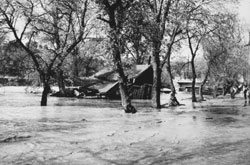 Lieutenant John P. Connor, commander of the Royal Canadian Sea Cadet Corps, described his experience in Woodbridge: "Once in Woodbridge, we were placed under command of the fire department and were assigned street detail. Our purpose was to walk alongside of the whalers and check houses for stranded inhabitants. The water was fast-moving and chest-deep, and it took a dozen people to guide the craft through the current. One learned very quickly to keep a good grasp of the boat, as unseen culverts caused more than one temporary disappearance of the crew."
Lieutenant John P. Connor, commander of the Royal Canadian Sea Cadet Corps, described his experience in Woodbridge: "Once in Woodbridge, we were placed under command of the fire department and were assigned street detail. Our purpose was to walk alongside of the whalers and check houses for stranded inhabitants. The water was fast-moving and chest-deep, and it took a dozen people to guide the craft through the current. One learned very quickly to keep a good grasp of the boat, as unseen culverts caused more than one temporary disappearance of the crew."
(Hurricane Hazel, Betty Kennedy, 1979; p. 79-80)
Holland Marsh
The Holland Marsh was flooded when between four and 20 feet (1.2 - 6.1 metres) of water backed up from Lake Simcoe into the marsh. The south and west ends experienced the worst flooding when between 20 and 30 feet (6.1 - 9 metres) of water backed up from the bordering Holland River and Schomberg Creek into the marsh.
The nature of the flood in Holland Marsh differed from that in the narrower river valleys in Toronto. The Holland Marsh flood was characterized by Charlie Davis, a local resident: "It wasn't like down by the Humber, where there was a big rush of water. The water was really quiet and it was so dark outside you couldn't really see what was going on. But every time you looked out the door, the water had risen another six inches." (Toronto Star, October 14, 1984)
- Highway 400, which dissects the marsh, was under five to 10 feet (1.5 - 3 metres) of water and the hamlet of Ansnorveldt was inundated.
- Approximately 1,000 people were rescued from the north end of the marsh towards Bradford, while hundreds more were stranded throughout the night on high ground until rescue boats could be launched.
 Severe economic losses were experienced because while much of the year's crop had been harvested, it had yet to be removed from the property for sale and was submerged by floodwaters.
Severe economic losses were experienced because while much of the year's crop had been harvested, it had yet to be removed from the property for sale and was submerged by floodwaters.
- Most of the properties were inundated with water, destroying or seriously damaging the homes and contents.
- The Holland Marsh became a lake in the flood and one house became a life raft for an entire family. The De Peuter family spent the night stranded in their house as it floated around the marsh.
- A housing crisis developed because of the number of displaced residents of the marsh who required prolonged emergency housing. Hundreds of homes were condemned by the health department because of contamination from the floodwaters and rotting vegetables.
- Seven thousand acres (28.35 kilometres˛) of marsh area were turned into a lake by the flood, destroying 500 homes and rendering 3,000 people homeless. Early estimates of damages were up to $10,000,000.
- Engineers decided to block a conduit under Highway 400 to allow pumps to begin draining the eastern section. The timing required to pump the marsh dry was placed at weeks.
- Fifteen feet (4.6 metres) of water had to be pumped into Lake Simcoe before the marsh could be navigated by the heavy equipment necessary for repairing damage. Plans to sacrifice one-fifth of the marsh to save the rest were agreed upon.
- Steep Rock Mines in Atikokan shipped three 23,000-gallon pumps, the army detachment in Oakville sent 10 large-capacity pumps and Ontario Hydro installed a 30,000-gallon pump on the dyke that separated Lake Simcoe from the marsh.
- The procedure for draining and restoring the marsh was nicknamed 'Operation Mop-up'. The operation involved approximately 2,000 men over 15 days, plus private contractors working with heavy equipment. The water reflected a horrible stench from the floating, rotting vegetables. Pumps had to contend with vegetables clogging their intakes.
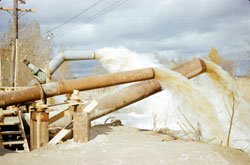 In total, 19 pumps using 25,000 horsepower, forcing the set up of three emergency substations, ran continuously to drain Holland Marsh. The water level was reduced by one-acre foot every minute and a half for a total average lowering of two inches per day (50.8 millimetres).
In total, 19 pumps using 25,000 horsepower, forcing the set up of three emergency substations, ran continuously to drain Holland Marsh. The water level was reduced by one-acre foot every minute and a half for a total average lowering of two inches per day (50.8 millimetres).
- Approximately six to eight billion gallons (23 - 30 billion litres) of water were pumped from Holland Marsh's 5,000-acre (20.25 kilometres˛) eastern section in 24 days, 11 days ahead of schedule. The 2,000-acre (8.1 kilometre˛) section of the marsh lying east of the highway was also reclaimed from the floodwaters.
- Farmers rushed to prepare their fields for the next year in an attempt to salvage their 1955 crops, which were especially rich due to the flood in 1954. Floods enrich the soil with a high mineral content due to the influx of mineral rich sediments brought with the floodwaters. The destruction of Hurricane Hazel also allowed farmers in the marsh to modernize and automate their operations, making them more profitable.
Long Branch
- Etobicoke Creek overflowed its banks, flooding three Long Branch streets completely, killing seven people.
- Several houses were washed into Lake Ontario, many while their occupants watched from higher ground or roof tops, but some with the residents still inside.
- Firemen and police rescued people from their homes, moving them to higher ground or roof tops. People pulled into the lake were rescued with ropes.
- Island Road and 43rd Street, south of the Lakeshore highway, were very badly damaged by the floodwaters. Most of the houses were condemned for fear of an epidemic.
- Four hundred people were evacuated from Pleasant Valley Trailer Park as the creek flooded. The park held 140 trailers. Trailers 40 feet (12.2 metres) in length were picked up by the river and rammed into other buildings. Other trailers that were not entrained by the river had to be towed away from the contaminated area.
- Andrew Tannock of Island Road, Long Branch, was presumed dead when his house was swept from its foundation towards Lake Ontario. Tannock climbed into the rafters of the house and rode it to the lake. When the house touched down, he climbed out of the house and swam to shore.
- Reeve Marie Curtis of Long Branch was quoted as saying, "If it hadn't been for the trees, which held the houses back, half of them would have been swept out into the lake." (Globe and Mail, October 18, 1954). For example, two trees prevented a house with 35 people perched on the roof from floating into the lake.
- A suggestion was made that the flooded area in Long Branch be converted into a park because 700 residents were removed from the trailer park and the two condemned streets. Councillor Len Ford was quoted as saying, "We, in Long Branch, are hoping to have at least the southern part as a park; a part of the Metropolitan area's green belt. There have been too many floods to allow people to live here."
- Residents were convinced to leave the area after the Hurricane Hazel flood. Three quarters of the people left.
- The local government requested that the provincial and federal governments purchase 192 properties on Island Road, 42nd Street, 43rd Street and Lake Promenade. The area had been condemned because of health reasons. A sanitary sewer serving the area prior to the storm was seven feet below the riverbed, but after the storm, the sewer was located three feet above the riverbed. Of the 192 properties requesting expropriation, 43 were totally destroyed, 68 seriously damaged, 37 slightly damaged, 30 garages destroyed and one store was seriously damaged. Preliminary damage estimates were greater than one million dollars. A plan was proposed to clear 300 homes from the lower elevations at a cost of $1,600,000 and create a 35-acre park.
Storm Orphan
Nancy Thorpe, a four month-old baby was the only survivor of a family from Island Road in Long Branch, and has been dubbed the 'storm orphan'. The mother handed Nancy to a fire chief, who carried her across the road. When he returned to assist the rest of the family from the house, he discovered that the house had floated out to the lake. Nancy spent Christmas with her aunt and uncle after which, no more media reports regarding her whereabouts could be found.
|
Don River
- Two cars were in the Don River after they were swept by floodwaters off the road. The three occupants were rescued.
- Edrich Moir found temporary refuge in the crotch of an elm tree, where he remained for eight and a half hours until rescuers located a 20-ton road grader to drive into the river to reach the man. The force of the river moved the vehicle sideways.
- One stranded motorist was rescued by an aerial ladder being swung over the river, with Captain Perry Stewart on the tip, where he threw a rope to Alex Nicholson of Pottery Road. Nicholson was able to tie the rope around his waist, but he was dragged underwater part of the way towards shore.
|
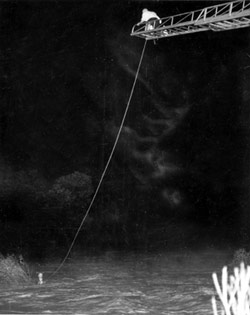
Sun Media Corp.
|
 The Humber River rose and flooded the lower portion of Raymore Drive, removing 1,200 feet (366 metres) of the street and 14 homes, killing more than 30 people. Raymore Drive curved in the southern portion, with Gilhaven Avenue acting as a radius. The lower section was devastated, removing homes on both sides of the street. On the east side of the street, a few trees remained, but on the west side, the street was lined with rocks, boulders and debris that was transported by the floodwaters.
The Humber River rose and flooded the lower portion of Raymore Drive, removing 1,200 feet (366 metres) of the street and 14 homes, killing more than 30 people. Raymore Drive curved in the southern portion, with Gilhaven Avenue acting as a radius. The lower section was devastated, removing homes on both sides of the street. On the east side of the street, a few trees remained, but on the west side, the street was lined with rocks, boulders and debris that was transported by the floodwaters.
 Twenty houses and every trailer in Glendale Mobile Home Park were destroyed, and another 50 houses in Pine Grove and Woodbridge were damaged.
Twenty houses and every trailer in Glendale Mobile Home Park were destroyed, and another 50 houses in Pine Grove and Woodbridge were damaged.
 Lieutenant John P. Connor, commander of the Royal Canadian Sea Cadet Corps, described his experience in Woodbridge: "Once in Woodbridge, we were placed under command of the fire department and were assigned street detail. Our purpose was to walk alongside of the whalers and check houses for stranded inhabitants. The water was fast-moving and chest-deep, and it took a dozen people to guide the craft through the current. One learned very quickly to keep a good grasp of the boat, as unseen culverts caused more than one temporary disappearance of the crew."
Lieutenant John P. Connor, commander of the Royal Canadian Sea Cadet Corps, described his experience in Woodbridge: "Once in Woodbridge, we were placed under command of the fire department and were assigned street detail. Our purpose was to walk alongside of the whalers and check houses for stranded inhabitants. The water was fast-moving and chest-deep, and it took a dozen people to guide the craft through the current. One learned very quickly to keep a good grasp of the boat, as unseen culverts caused more than one temporary disappearance of the crew." Severe economic losses were experienced because while much of the year's crop had been harvested, it had yet to be removed from the property for sale and was submerged by floodwaters.
Severe economic losses were experienced because while much of the year's crop had been harvested, it had yet to be removed from the property for sale and was submerged by floodwaters.
 In total, 19 pumps using 25,000 horsepower, forcing the set up of three emergency substations, ran continuously to drain Holland Marsh. The water level was reduced by one-acre foot every minute and a half for a total average lowering of two inches per day (50.8 millimetres).
In total, 19 pumps using 25,000 horsepower, forcing the set up of three emergency substations, ran continuously to drain Holland Marsh. The water level was reduced by one-acre foot every minute and a half for a total average lowering of two inches per day (50.8 millimetres).
